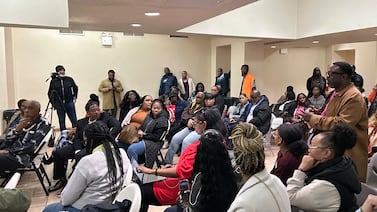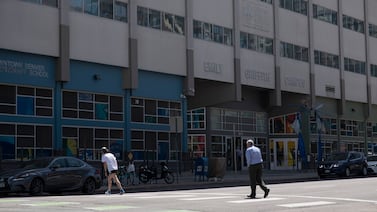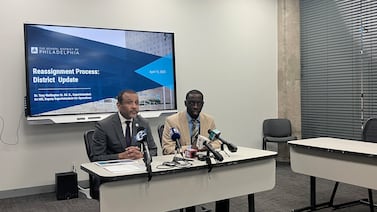Sign up for Chalkbeat New York’s free daily newsletter to keep up with NYC’s public schools.
After one of Clara Delgado’s students gave birth late last year, she quickly arranged a home visit.
A staffer at Downtown Brooklyn’s Young Adult Borough Center — one of the Education Department’s evening programs for students who are behind in credits or can’t attend school during the day — Delgado arrived with a counselor in tow, donated baby clothes, and made sure the student could log in to Google Classroom to complete assignments remotely.
Delgado hoped the message was clear: The school would do whatever it could to help the teen finish the two classes she needed to graduate.
But staff like Delgado — along with funding for about 3,000 paid work slots — could soon disappear from a network of Young Adult Borough Centers and transfer schools that collectively serve nearly 15,000 students who have struggled at traditional high schools, are behind in credits, and are at risk of dropping out. That’s because a bevy of counselors, social workers, and internship coordinators, are paid through a city initiative called Learning to Work, which is predominantly funded by federal dollars that will expire at the end of this school year.
Educators and advocates say the services provided through Learning to Work are a lifeline for high-need students who enroll in transfer schools and evening classes. Those students include those who have struggled to pass classes at traditional schools, are caught up in the criminal justice system, are parents themselves, or are living in temporary housing.
To help get those students back on track, Learning to Work pairs alternative schools with community organizations that provide extra staff who help ensure students show up to school, get connected to social services, and even help craft college and career plans. It also funds thousands of paid internships, which can give students valuable work experience and create an incentive to attend school rather than dropping out to support themselves.
“A lot of [our work] is social-emotional,” said Delgado, a program manager at Good Shepherd Services, a nonprofit organization that partners with the Brooklyn night program. “They need somebody to take that off their plate so they can be successful with the academics.” The student who gave birth earned a diploma last month and plans to enroll at the Borough of Manhattan Community College this fall.
If the program’s funding is cut, Delgado said it will be a blow for students who have already struggled with the city’s education system. “It’s just someone writing them off again – they’re getting another back turned on them,” she said.
Jobs for students and staff could be lost
Learning to Work has existed since 2005, unlike other programs funded with federal dollars that were intended to address the pandemic’s fallout, such as Saturday programming for students with disabilities or expanded summer school.
But the city began using federal money to finance most of the program two years ago. Nearly 70% of Learning to Work’s budget, or about $32 million, now comes from one-time federal pandemic relief funds, according to the city’s Independent Budget Office. (The program faced a 25% cut in 2020, but its budget has since returned to pre-pandemic levels.)
Without an infusion from the city, “on July 1 these young people lose their support system and lose money they’re paying their bills with,” said Michael De Vito Jr., executive director of the New York Center for Interpersonal Development, which operates three Learning to Work programs across Staten Island and Brooklyn. “This is also going to cause layoffs of hundreds of nonprofit workers.”
Ariana Rivadeneira, 22, said the paid work experiences helped her re-engage with school and ultimately earn a diploma. Before the pandemic hit, she took on a job working at a veterinary clinic to help her mother pay rent after her parents split up. She began missing school and fell behind academically.
But after switching to West Brooklyn Community High School, a transfer school, the staff helped line up paid work experiences and training, including solar panel installation. There was suddenly less of a tradeoff between school and work.

“I was able to focus and redirect my whole education path to school,” Rivadeneira said. She graduated a year ago and now works as an EMT.
The work experiences helped Rivadeneira and her peers “experience what life could be for them – not just school, not just this responsibility of, ‘you have to graduate,’” she said.
Transfer schools could be hit hardest
The previous mayor, Bill de Blasio, made the decision to use one-time federal funding to support the Learning to Work program, but it’s unclear how Mayor Eric Adams will proceed. Adams and schools Chancellor David Banks have made career education a centerpiece of their agenda, and many advocates hope city officials will see the program’s connection to that work.
Still, community organizations worry that the program is not on the city’s radar, as Adams said in January that he “had no clue of the extent of how many programs were being funded by stimulus dollars” until he was briefed by Banks. And while Adams has restored some initiatives that were funded with one-time federal money, there are many remaining programs that are competing for city dollars, including preschool for 3-year-olds.
“We constantly have to remind people that we even exist,” De Vito said. “It seems like the network [of alternative programs] at large is just an afterthought.”
The city has not made a final decision about the program’s future, Education Department spokesperson Chyann Tull wrote in an email. “We are engaging with Learning to Work providers as we plan for the future and recognize the importance of this impactful programming for our city’s young people,” she said. “We continue to advocate to our state and local partners to identify new funding to sustain these programs after this year.”
But even if the funding is restored in the city budget, which is finalized in June, some staff are already heading for the exits, as workers realize that funding for their jobs is uncertain, De Vito said.
If the cuts go through, they could add to an existing funding threat to the city’s network of transfer schools, which serve older students who are off track to graduate and may face smaller budgets next year. Enrollment at transfer schools was roughly 12% lower last school year compared with pre-pandemic levels, while traditional high school rosters fell just 2%. Federal relief funding that kept school budgets afloat despite enrollment losses is also set to expire.
With the possible cut to Learning to Work, one Brooklyn transfer school principal said the consequences could be “catastrophic.”
The principal, who spoke on condition of anonymity, noted that the community organization that partners with the school and is funded by Learning to Work, helps students with everything from getting clean clothes to lining up a paid internship “so they don’t have to choose between school and earning a living.”
Without those efforts, the school would have to entirely rethink its approach. “From the beginning our school has been designed with a [community organization] partner – not just as an appendage,” the principal said. “You can’t tear off a chunk of your school and assume that there’s some way to replace it.”
Alex Zimmerman is a reporter for Chalkbeat New York, covering NYC public schools. Contact Alex at azimmerman@chalkbeat.org.







